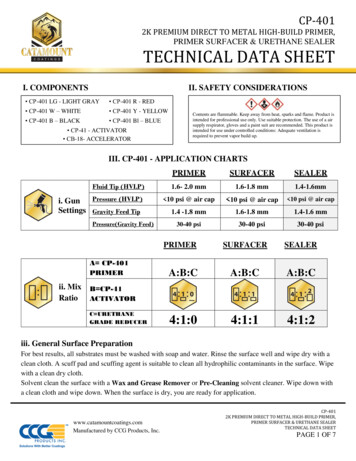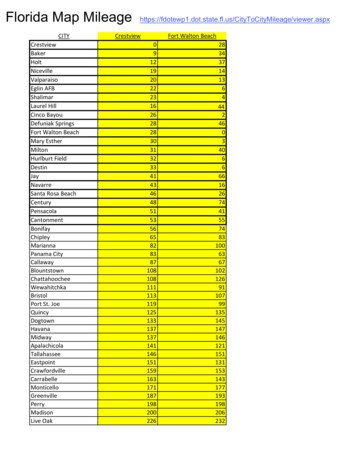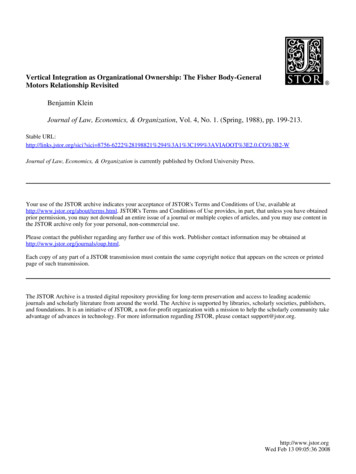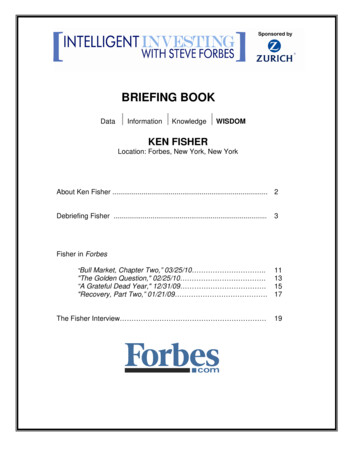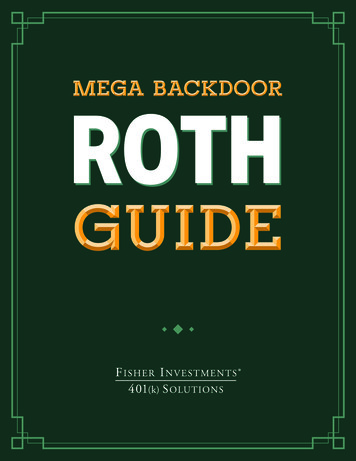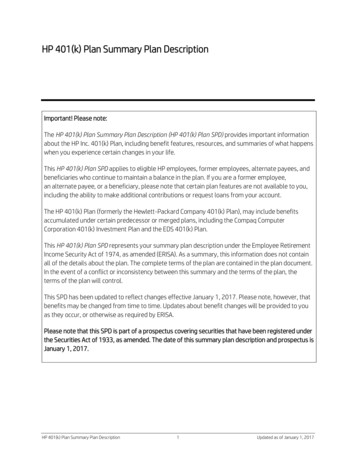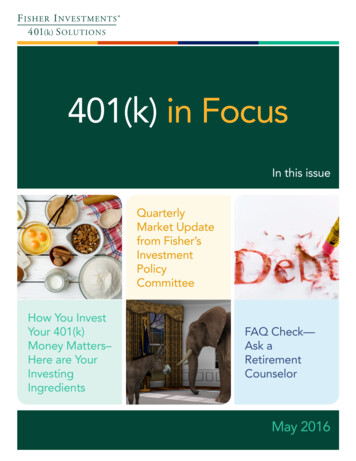
Transcription
401(k) S OLUTIONS401(k) in FocusIn this issueQuarterlyMarket Updatefrom Fisher’sInvestmentPolicyCommitteeHow You InvestYour 401(k)Money Matters–Here are YourInvestingIngredientsFAQ Check—Ask aRetirementCounselorMay 2016
401(k) S OLUTIONSHow You InvestYour 401(k) MoneyMatters—Here are YourInvesting IngredientsIn baking, the difference between a cake that’s merelyedible and one that’s truly great is the ingredients and theirproportions. Similar rules apply in investing; selecting justthe right type of investments in the correct proportionscan mean the difference between just retiring, and retiringin the way you choose.Your basic investing ingredientsThe basic investment types are stocks, bonds, cash, andother securities. To keep things simple for this discussion,let’s stick with stocks and bonds.Stocks, also known as equities. A stock is an ownershipshare of a company, representing a claim on the company’sassets and earnings. 401(k) investors (like you) may ownstocks directly. But more commonly, they own stocksthrough mutual or collective funds. These funds pooltogether money from many investors to purchase shares ofa number of different companies. The stocks may be fromsmall companies, very large companies, utility companies,or some other category. The fund owns the shares, andinvestors purchase shares of the fund.Over time, stocks generally have higher investment returnsthan bonds. At the same time, they tend to experiencemore of the ups and downs of the markets. This is known2as volatility. It makes sense that stocks are volatile, becausejust as the economy and market factors change, companiesalso experience ups and downs. However, even thoughstocks may experience dramatic fluctuations in the shortterm, research shows that they tend to even out over thelong run.Bonds, also known as fixed income securities. You canthink of a bond as a loan you make to a government,corporation, or another entity. When you loan themthe money, they owe it back to you, plus interest. Bondcertificates are like IOUs. The borrower (also called theissuer) uses the certificate to tell you when the loan will berepaid and how much they will pay in interest. Bonds tendto be more stable than stocks, but also tend to have lowerinvestment returns.Generally, 401(k) plan investors put money into fixedincome securities by purchasing shares of a fixed incomemutual fund or collective fund, rather than purchasingindividual bonds.Putting them together—your assetallocationStocks and bonds perform differently depending oncurrent economic, political and sentiment-based marketdrivers. They may enjoy both highs and lows, which is whyit’s important to invest strategically and in alignment withyour retirement goals.MAY 2016
For the younger person who has a long time beforeretirement, a sensible allocation might include asignificant percentage of stocks with the expectationof high returns. It might also include a small portion ofbonds, to offset the volatility that comes with stocks. Anindividual with only a few years left until retirement mightchoose to reduce their stock allocation and increase theirbond holdings in order to smooth out volatility while stillbenefiting from potentially higher returns. There are manydifferent scenarios—these are just two possibilities. As anindividual’s personal circumstances change before, up to,and through retirement, so might the way they allocatetheir retirement money across different asset types.Asset allocation is a crucial part of your investing success.We believe the majority of an individual’s account return isrelated to their asset allocation decisions. Some investorsfeel confident in their ability to review investment optionsand select a menu that’s right for them. But what if youdon’t feel equipped (or inclined) to decide how to allocateyour retirement account? Good news: you don’t have todo it alone.Your plan provides you with access to the RetirementNavigator, an online tool that helps you zero in on anasset allocation that matches your unique goals andcircumstances. This tool can help you understand keyissues about your individual situation so you can makeinformed investment decisions for your retirement needs.In just about 20 minutes, it will educate you while leadingyou through a series of questions designed to get to theheart of your individual retirement goals and objectives.The Retirement Navigator is designed to provide anasset allocation using a mix of equities and fixed incomeinvestments that’s right for your individual circumstances.if you ever have any questions about asset allocation orthe Retirement Navigator, be sure to call the Fisher 401(k)Solutions Help Desk at 888-322-7586.Are you selecting ingredients that will help your retirementsucceed? Remember, the right blend of ingredients canmake a big difference. Now’s the time to make sure you’refollowing a recipe to retirement success.Fisher Investments 401(k) Solutions’ assetallocation model portfolios include:Fisher Investments 90% Equity 10% Fixed IncomeFisher Investments 70% Equity 30% Fixed IncomeFisher Investments 60% Equity 40% Fixed IncomeFisher Investments 50% Equity 50% Fixed IncomeFisher Investments 30% Equity 70% Fixed IncomeFor those who want to choose their ownmix, the following collective fund options areavailable:Fisher Investments All World Equity Collective FundFisher Investments US Fixed Income Collective FundFisher Investments Foreign Equity Collective FundFisher Investments US Equity Collective FundFisher Investments Emerging Markets EquityCollective FundPlease see an important disclosure about the FisherInvestments Collective Funds on page 8.As life changes come along, you can revisit the RetirementNavigator. Updating your information will help youdetermine if you’re still in the right allocation mix, or ifit’s time to make a change. The same applies to investorswho manage their own portfolios—change happens,and those changes may require changes in investments,too. A periodic review will help keep you on track. AndMAY 20163
401(k) S OLUTIONSQuarterly MarketUpdate from Fisher’sInvestment PolicyCommitteeonly if we forecast a bear market—a long, fundamentallydriven downtrend exceeding -20%. It takes a negativesurprise quashing trillions in economic activity to drivea bear market. We don’t see a sufficiently powerful,surprising negative lurking unnoticed to end the bullmarket right now.Global markets rallied in Q1’s second half, erasing anearly-year slide to finish the quarter down just slightly.While sharp downswings like January’s are uncomfortable,strong returns in late February and March show howquickly corrections can reverse, rewarding disciplinedinvestors. We believe stocks will keep rewarding disciplineas the bull market continues this year.2016 seems set to become the Year of Falling Uncertainty.The year began with huge uncertainty surrounding USelections, low oil prices, China, negative interest ratesand the UK’s looming “Brexit” vote on staying in the EU.None are disastrous, but combined they fueled massivefear. As these fears sunset and uncertainty falls, reliefshould boost stocks. Some, like the “Brexit” vote and USelections, have fixed expiration dates, which should bringinvestors more clarity, while others fade with time.The year’s early downturn may be over—it will only beclear in hindsight—but another correction later this yearis always possible. Corrections (short, sharp downturnsexceeding -10%) result from sentiment’s unpredictablewhims. They don’t operate on schedules, so the fact wejust had one doesn’t prevent another. In our view, thebest course of action when sharp downdrafts strike is tostay calm. It can be tempting to try to time correctionsfor fear they’ll fall further, but such moves often backfire,and can jeopardize your long-term goals through missedopportunity. We recommend reducing equity exposure4America’s election is seven months away and stillimpossible to handicap, but markets will steadily gainclarity. The field has narrowed. Hillary Clinton is the likelyDemocratic nominee, and the GOP is Donald Trump’sto lose. Yet events could derail either campaign, souncertainty persists. Most of this fog should dissipate byconvention season, giving markets fewer wild scenariosto fret and helping investors narrow their focus and pricein the outcome. On November 8, uncertainty evaporates,letting investors get on with life—a powerful positive.While politics are worth assessing, we believe it’s crucialto accept that no party is superior, and no candidateis automatically good or bad for markets. Politicsare emotional, and bias blinds—hence our politicalagnosticism. Markets have performed well and poorlyunder both Democrats and Republicans. Headlinesspeculate on whether Trump, Clinton, Bernie Sanders,Ted Cruz and the rest will be good or bad for markets—allbluster, no substance. Campaign rhetoric rarely becomeslaw, as presidents moderate or hit a Congressional brickwall. Moreover, stocks price all opinions, good and bad.MAY 2016
Fear will be baked in soon enough, allowing markets towarm to the eventual winner. The closer the election, themore markets will embrace the victor.Other lingering questions should similarlyfade. “Brexit” will be clear after the June23 referendum. If the UK stays in theEU, markets will likely cheer the statusquo. If it leaves, at least we’ll know,and after some uncertainty, marketswill see it isn’t the disaster mostpresume. Fears of China, negativerates and low oil prices lack fixed endIf you would like to learn more about the stock market orhave any questions or need assistance with your 401(k),we encourage you to contact your company’s FisherRetirement Counselor or call the Fisher 401(k)Solutions Help Desk at 866-322-7586.Asearningsand economicgrowth beat dourexpectations,uncertaintyshould fall.- The Investment Policy Committeedates but are either misinterpretedor small, and investors should get overthem soon enough. China is growing, notcollapsing. The Eurozone has had negativerates since June 2014, yet it has grown, with lendingand broad money growth improving. Energy earnings andinvestment have already fallen, but the detraction fromearnings will soon cease, making growth elsewhere moreapparent. As earnings and economic growth beat dourexpectations, uncertainty should fall.Soon investors will see plenty to cheer. The worldcontinues growing, powering profits in most sectors.Broad money supply growth has accelerated throughoutthe world. Central banking is flawed but not choking offgrowth. All augur well for capital markets and the globaleconomy. Politically, gridlock has escalated in much of thedeveloped world, reducing legislative risk. Annoying asthe in-fighting might be, stocks love it, as it reduces therisk of sweeping change creating winners and losers.The world is full of unseen positives, with extant negativestoo small or too widely known to wallop stocks. Investorsaren’t euphoric or complacent. Rather, expectations aretoo dour. This isn’t a time to be fearful. This is a time toappreciate what the uncertain masses miss and enjoy acontinued bull market.MAY 20165
401(k) S OLUTIONSexperts recommend an emergency fund of at least 1,000in an easily accessible savings account. This is an importantstep because you’ll have your emergency fund availablewhen life’s inevitable emergencies come up. And if you havethe money saved, you won’t have to use your credit cards.Once your spending is under control and you’ve establishedyour emergency savings, it’s time to decide—save in your401(k) or pay off your credit card debt.FAQ Check—Ask a RetirementCounselorI have a lot of credit card debt.Should I be contributing to my 401(k)or should I pay down my credit carddebt first?This is a common question. Accumulating credit carddebt is easy to do—studies show we tend to spend morewhen we use plastic than cash.¹ Currently, 34% of U.S.households carry revolving credit card debt from onemonth to the next,² and the average credit card balanceper borrower was 5,142 in the first quarter of 2015.3 Sowhat’s the best course of action?Experts agree—the first thing to do is control your spendingand stop adding to your debt. Because let’s face it, it’sdifficult to save if you’re still racking up debt.But before you decide, ask this—does your employer offera matching contribution? If so, you’ll want to save enoughin your 401(k) plan to take advantage of the employermatch first. It will likely pay you more in the long-run andoffset any interest you’ll pay on your debt.No matching contribution? Then focus on paying off yourdebt first. Eliminating high interest payments will likelyoffer you the greatest long-term return. Just be diligentand pay your debt down as quickly as possible so youcan start putting money where it really counts—in yourretirement account and towards your future.About Andrew FadenrechtAndrew Fadenrecht has worked in the retirementplan industry for more than 8 years. He joined FisherInvestments 401(k) Solutions in 2015 as a RetirementCounselor. Prior to that, Andrew worked at BCIGroup, Inc. as a Retirement Plan Advisor.Andrew received his B.S. in Business Administrationwith a concentration in Finance from the CharlesH. Lundquist School of Business at the Universityof Oregon.The next thing to do is create an emergency fund. Again,Raghubir, Priya, and Joydeep Srivastava. “How You Spend Affects How Much You Spend: Credit, Scrip and GiftCertificate Purchases Found to Be Higher than Cash Buys.” American Psychological Association. American PsychologicalAssociation, 7 Sept. 2008. Web. 21 Mar. 2016.²Harris Poll. “The 2014 Consumer Financial Literacy Survey.” The National Foundation for Credit Counseling (NFCC),2014. Web. 4 April 2016.3TransUnion. “TransUnion: Credit Card Debt and Delinquency Rate Remain Steady As 15 Million More Accounts Openedin Last Year.” 20 May 2015. Web. 4 April 2016.16MAY 2016
Check It OutRetirement Calculators Can Add Up to Bigger SavingsWant to have a more successful retirement? Research has shown that individualswho use tools like retirement calculators are more likely to successfully planand achieve their retirement goals than those who don’t.¹ Calculators are agreat way to help you plan your financial future, save, and achieve a moresecure financial outcome.But not all retirement calculators are created equal.² Some just don’t dig deepenough into your current financial state to give a solid assessment of your futurefinancial needs. The best retirement calculators ask a variety of questions andgenerally require more than a few moments to complete.It’s also a good idea to use a few different calculators for comparison. Checkout your 401(k) online account portal for the retirement calculator located thereand the following free retirement calculators:Dinkytown.net Retirement PlannerSimple, estimation-based input, good visuals and reporting.ICMA-RC Retirement CalculatorsMultiple calculators considering retirement income, adjusts for other income streams.The Social Security Administration CalculatorsMultiple calculators designed to explain your future social security benefits.Lusardi, Annamaria, and Olivia S. Mitchell. FINANCIAL LITERACY AND PLANNING: Implications forRetirement Wellbeing; Working paper no. 17078. Cambridge: Oxford UP, 2011. Print.²Damato, Karen, and Anne Tergesen. “New Study Questions Retirement Planning Calculators’ Accuracy.” TheWall Street Journal, 22 Feb. 2016. Web. 21 Mar. 2016.1CONTACT USIf you have a 401(k) account serviced by Fisher Investments 401(k) Solutions and need help or have anyquestions, please contact us at 888-322-7586. We can help you with your 401(k) account, including assistancewith technical or operational issues, as well as other service needs. We can help answer questions aboutthe latest news developments and what it may mean in terms of investments and retirement planning.ABOUT FISHERFisher Investments 401(k) Solutions is dedicated to helping business owners and their employees successfullyreach their retirement goals. We help people better optimize their retirement savings opportunities andunderstand their retirement plan options through in-person enrollments, ongoing education and our liveperson Help Desk.MAY 20167
Investing in stock markets involves the risk of loss. Past performance is never a guarantee of future returns. This newsletteris intended for educational purposes only. It constitutes the general views of Fisher Investments and should not beregarded as personalized investment or tax advice or as a representation of investment performance. No assurances aremade that Fisher Investments will continue to hold these views, which may change at any time based on new information,analysis or reconsideration. In addition, no assurances are made regarding the accuracy of any forecast made herein. Notall past forecasts have been, nor future forecasts may be, as accurate as any contained herein.Each of the model portfolios on page 3 is comprised of investments in the Fisher Investments All World Equity CollectiveFund and the Fisher Investments US Fixed Income Collective Fund. All of the funds identified on page 3 are separatecollective investment funds within the Fisher Investments Collective Trust (“Trust”). The Trust is a bank collective trust forthe collective investment of assets of participating tax qualified pension and profit sharing plans and related trusts, andgovernmental plans as more fully described in the Declaration of Trust and is exempt from registration as an investmentcompany. The Trust is available only to plan participants and sponsors within such qualified plans. This does not constitutean offer to sell or a solicitation of an offer to buy shares of the funds within the Trust. SEI Trust Company (the “Trustee”)serves as the trustee of the Trust. The Trustee is a trust company organized under the laws of the Commonwealth ofPennsylvania and wholly owned subsidiary of SEI Investments Company. The Trust is operated by the Trustee and theTrustee maintains ultimate fiduciary authority over the management of, and the investments made in, the Trust. The Trustis managed by the Trustee, based on the investment advice of Fisher Investments, the investment adviser to the Trust. 2016 Fisher Investments.8K02163V May 2016
Fisher Investments 401(k) Solutions' asset allocation model portfolios include: Fisher Investments 90% Equity 10% Fixed Income Fisher Investments 70% Equity 30% Fixed Income Fisher Investments 60% Equity 40% Fixed Income Fisher Investments 50% Equity 50% Fixed Income Fisher Investments 30% Equity 70% Fixed Income For those who want to choose .



